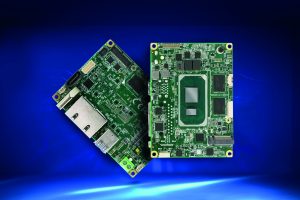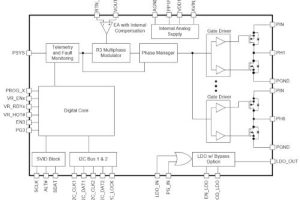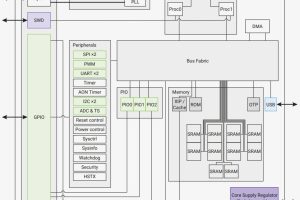
Artificial intelligence chipset on circuit board in futuristic concept technology artwork for web, banner, card, cover. Vector illustration
After the trials and tribulations of the past two years 2014 may seem a long time ago, but in general terms seven years is not a significant amount of time. In the world of computing, however, in particular that of computer chips, with every two years that ticks by Moore’s Law dictates that advances in technology should be doubling transistor counts exponentially.
To stay true to Moore’s Law, in a perfect world we should essentially be three times more advanced than we are now.
But due to technical challenges, the global pandemic and IC shortages, it has taken much longer for manufacturers to develop their technology, but Intel has finally brought out two new chipsets for manufacturers of boards for the embedded, industrial, and commercial spaces to take their own technology to the next level.
During the past seven years, the 14nm finfet architecture has reigned supreme, with its debut in the form of Skylake in 2014. With astonishing 10nm silicone, allowing for an extra 63m transistors in the same area, Intel’s Tiger Lake and Elkhart Lake are set to knock the 14nm finfet architecture off its perch.
Elkhart Lake
Elkhart Lake is Intel’s codename for the latest range of Atom, Pentium and Celeron processors. It is the successor to 2016’s Apollo Lake, which features in millions of embedded devices around the world.
In the five years since Apollo Lake was released, 5G and Wi-Fi6 have been standardised, artificial intelligence has exploded, and the number of IoT-connected devices has doubled to 35.8 billion, according to Statista. Elkhart Lake has support for these technologies and applications, and as single board computer (SBC) and embedded system technology advances, it is in prime position to power some embedded and IoT projects.
Elkhart Lake chips range from 6W to 12W TDP (thermal dynamic performance), and initial benchmarking shows that they can offer more than twice the performance in both single and multi-threaded applications compared with their Apollo Lake predecessors, while using the same power and generating roughly the same heat output.
Elkhart Lake chips can support up to 16Gbyte of 3200MT/s LPDDR4x or 32Gbyte of DDR4 3200MT/s, which is an increase of two and four respectively, as well as a 1.5x increase in maximum memory bandwidth. Additionally, the Elkhart Lake series can support in-band error correction code memory to ensure the accuracy and integrity of data being processed at the edge.
For embedded systems, perhaps the largest benefits are the optional functional safety support on some stock keeping units, as well as the support for three 2.5-Gbit local area network (LAN) integrated into the SoC. This is much more convenient than the requirement for an additional network interface controller on the previous Apollo Lake devices.
 These integrated 2.5-Gbit media access controls feature time-sensitive networking capabilities, a set of standards that provide support for the latest real-time networking procedures, reduce network complexity and streamline the cost of ownership of networks in general.
These integrated 2.5-Gbit media access controls feature time-sensitive networking capabilities, a set of standards that provide support for the latest real-time networking procedures, reduce network complexity and streamline the cost of ownership of networks in general.
Tiger Lake
Tiger Lake has the same 10nm silicone as its Elkhart Lake cousin. On paper there is not much to distinguish Tiger Lake’s Core i7-1185G7E from its predecessor, the Whiskey Lake Core i7-8665UE. Both have four cores, eight threads and a top speed of 4.4GHz. Power usage is the same at 15W TDP, and both support 64Gbyte memory. The Tiger Lake chipset offers 4Mbytes more L2 cache, but ultimately the two would be closely matched in single-thread applications.
Where the Tiger Lake 1185G7E shines, however, is in graphics. As Nvidia and AMD dominated the graphics processing unit (GPU) market, Intel ceased development in this area until around 2017, when it began developing the Iris Xe graphics platform, which is the company’s reintroduction to discrete GPUs. With a slimline version included in Tiger Lake Core i5 processors and upwards, Iris Xe is a huge step up from the HD and UHD integrated graphics of past iterations of Intel processors.
The Tiger Lake Core i7 1185G7E offers 96 execution units which, although Intel has not released any information on this specifically, appear to refer to the number of shader cores the CPU can offer. In the case of the 1185G7E, 96 execution units would equate to 768 shader cores, which is a four-fold increase on its predecessor, the 8865UE.
When partnered with the Intel Open Vino framework, which is supported by the Tiger Lake CPUs, the Iris Xe execution units dramatically boost the performance of machine-learning inference run times, exceeding the capabilities of the widely adopted Nvidia Jetson TX2 while on a single platform.
The advent of Elkhart Lake SBCs
Aaeon has developed two cutting-edge SBCs supporting Intel Tiger Lake and Elkhart Lake.
The Tiger Lake PICO-TGU4 offers Intel Celeron and Core i7/i5/i3 options with the i5 and i7 models, bringing Iris Xe graphics capabilities that can be used for inference at the edge. There are eight USB ports (two of which are USB3.2 Gen 2 ports for cameras), as well as two serial ports supporting RS-232/422/485, a 2.5-Gbit/s LAN port, an additional Gbit LAN Port, 8-bit DIO, HDMI, and electronic data processing for integration with an LCD. For storage, there is a serial AT attachment port with 5V power, and for expansion there are an M.2 2280 M-key and a mini-PCIe slot, which can be used for additional storage devices etc.
The PICO-EHL4 is an Elkhart Lake-powered SBC that supports Atom, Pentium and Celeron series processors.
For embedded systems requiring low-power usage, the Elkhart Lake processor powering the PICO-EHL4 operates at just 6W-12W TDP and is in a PICO-ITX form factor.
Input/output (I/O) features include two USB3.2 Gen 2 ports, two serial port headers supporting RS-232/422/485, two CANbus headers, dual Gigabit Ethernet, dual display via two HDMI ports, 4-bit digital I/O and a low-voltage differential signalling or eDP port for integration with an embedded display. There are also an M.2 2230 E-key for Wi-Fi and a mini peripheral component interconnect express slot for further expansion.
 Electronics Weekly
Electronics Weekly



